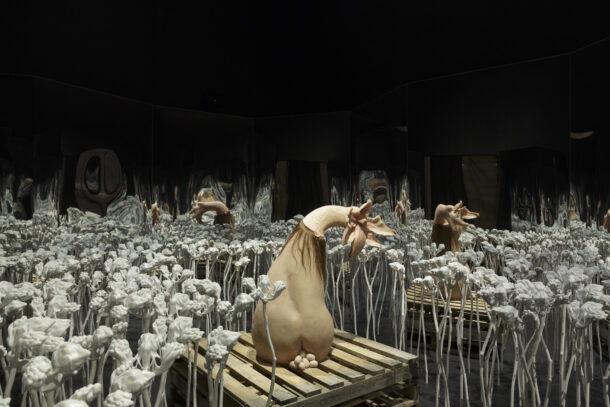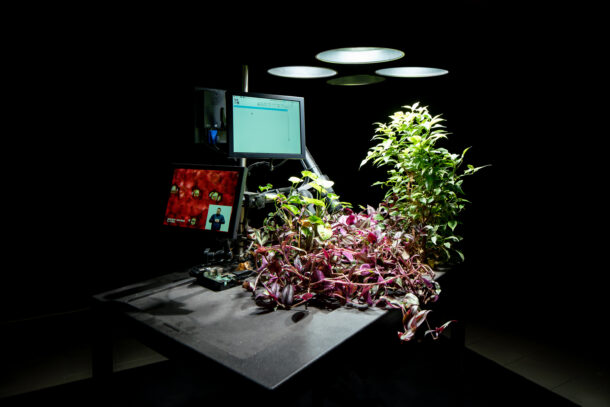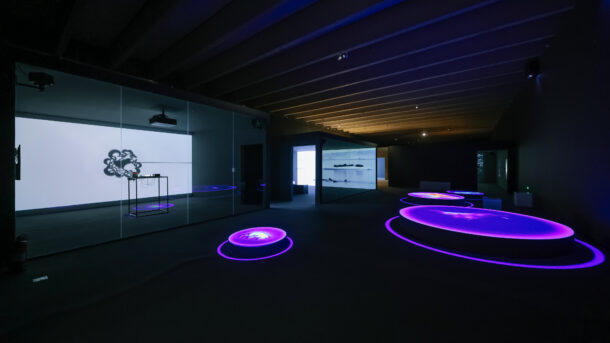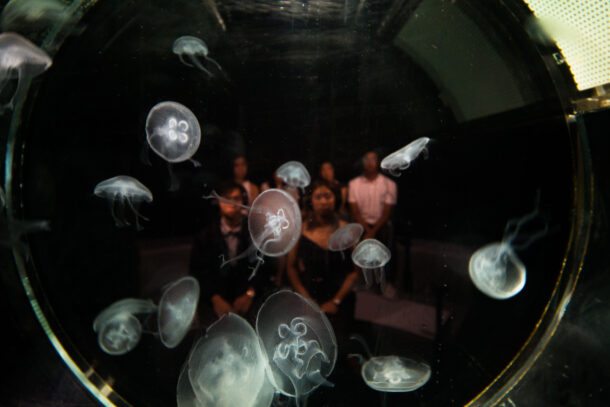Xeno-temporality in us: in Synthetic Ecology We are becoming strange strangers
| November 8, 2023

Patricia Piccinini, Bootflower, 2015
Courtesy the artist
“We are becoming strange strangers.”
How do we conceive a multi-species temporality, or lifespan? I have been bored with the banality of ‘flat ontology’ spreading out the art world, although undoubtedly the return to ontology is political and it challenges the Enlightenment humanistic paradigm of knowledge. Posthumanism clearly responds to such a Zeitgeist, attempting to construct a new ontology against dualism. A widely known approach would be to define humans and non-humans as equal actors (Latour and Harman) – an idea that has been filtering into our minds because of its neatness. On the other hand, Deleuzians often characterise complex configurations as a large, heterogeneous, porous assemblage (Haraway, Braidotti, Delanda). Exciting as these efforts to shape new concepts are, they remain silent in front of the apparatus in which power relations become real. There are still perceptual difficulties in understanding concretely – rather than conceptually – the agency in a non-human other or object. Since it is impossible to escape from humans’ cognitive categorisation of non-human species, they become either objectified through anthropomorphism, obliterated in a vast stretch of a network of relations, or alive in dark ontology’s realm – a closed door to humans, as Harman describes. Thus, we still need new discourses to nurture the roots of ontology.

Špela Petrič, Institue of Inconspicuous Languages: Reading Lips, 2018
Courtesy the artist
Strangeness Revisit
Strangeness might be one of the keywords for non-anthropocentric aesthetics. While philosopher and ecologist Timothy Morton refers to non-human entities as “strange strangers”, prompting us to examine and internalise the conflicts and splits between humans and non-humans – “from mitochondria and viral DNA code insertions to blue whales, comets and Earth’s electromagnetic field” (Morton 2013: 39) – as well as self and the othered, Julia Kristeva recognises that the incongruousness we have sensed might not be elsewhere but in ourselves. Strangeness of the stranger is embedded within us. If we develop it further through the lens of neo-materialism, strangeness is hidden within the subject, disturbing it from the inside. The subject is in an unstable state in constant oscillation and is understood as a substantial yet temporal embodiment of the energy from the earth materials’ movements in a time period. The self-other boundary is then made uncertain.
As Kristeva puts it, “Let us not seek to solidify, to turn the otherness of the foreigner into a thing. Let us merely touch it, brush by it, without giving it a permanent structure.” (Kristeva, 1991:3) By this, she reminds us not to rush to give strangeness a humanised nature. We can probably grasp it through its aesthetics. In the context of contemporary art practice, strangeness differs from the avant-garde of twentieth-century modern aesthetics. Although they both involve a degree of negativity, the avant-garde still represents a progressive conception of human reasoning. Strangeness, however, is ahistorical, and open-ended; it is concerned with disturbance and transformation rather than an ascending movement. It involves the recognition of other intelligent life forms, including artificial intelligence and various organic and inanimate substances. At the first Beijing Art & Technology Biennale: Synthetic Ecology, we are met by talking plants, virtual white rhinoceroses resurrected by AI, bionic archaea machines, an autonomous forest system through smart contracts, glaciers with a legal personhood, and a variety of other forms of life. The exhibition shows the continuous infiltration and shaping of human subjects as well as our social systems by complex material energy and technological media. It transforms our understanding of politics from a formally and culturally anthropocentric structure to an object-oriented dynamic, blurring the boundaries between entities and expanding the idea of strangeness within us.
Participatory politics of material
The political vision of ecological neo-materialism differs from general environmentalism (to protect nature and to consider nature as a resource are two sides of the same coin); it emphasises the agency of matter in complex environmental networks. The perceptual nature of plants, for example, is often overlooked because their characteristics cannot easily be superimposed on signs of consciousness expressed by human or animal subjects. In fact, plants are capable of learning from experience and environmental stimuli; they can interact and communicate not only with other plants but also with other organisms. Artist Špela Petrič develops a speculative experiment in human-plant communication, based on a research paper published in the journal Science. As plants can monitor the amount of water absorbed from their roots by opening and closing the stomata, these pores look like numerous mouths under a microscope, reminding us of the process of lipreading for the hearing-impaired. A linguist in Petrič’s experiment would then attempt to teach the plants some common semiotic codes – bringing in Pavlov’s classical conditioning – thus a meaningful communication between humans and plants is realised. However, would it be considered an approach to interspecies communication and conversation? Human languages have always been too exclusive. Yet Petrič’s experiment rejects the outstanding and singular position of humans as manipulators of symbols, stimulating a non-anthropocentric, participatory politics of material.
In artist Susan Schuppli’s critical investigation, the concept of ‘material witness’ plays an important role: nature seems to have the agency to register and accumulate information, instead of exploiting excessive inert resources. By investigating events such as the melting of the Arctic ice shelf and the oil spill, she reveals how material as a medium, while revealing and representing external events and geopolitical principles, becomes a pre-individual and non-human planetary force governing biological processes. ‘even minor forms of material evidence to gather and testify on behalf of much larger political processes.’ (Schuppli, 2020: 28). Amidst the melting, cracking and moving of ice, hidden, if not neglected, events become evident. Truth is also entailed by the sensitivity of materials and the activity of strangeness.

Terike Haapoja,Community, 2009
Exhibition view at Beijing Art & Technology Biennale: Synthetic Ecology, 798CUBE, Beijing, 2023
Photo: Liu Jinlong
Poetics of life, death and entropy
Entropy relates closely to the transfer and dissipation of energy. Irreversibly, time flows forward as entropy moves upward. As philosopher Isabelle Stengers puts it, “entropy has continued to fascinate us by its message of fatality, by its association with loaded terms: degradation, heat death, the arrow of time. ” (Stengers, 2010: 214). The power of entropy hides beneath the surface of the tangible world, and it is only after the system collapses into chaos that we start to understand the disruptive force of entropy. This is certainly mocking the engineering mastermind’s ill-conceiving nature: it sees life and species as a commodity that can be completely controlled, engineered and monopolised with technologies, such as nanotech, synthetic biology, cloning, geo-engineering, and cognitive engineering. However, all systems, including those of modern and contemporary cybernetics, are subject to the forces of entropy. For modern subjects frustrated by the desire for self-preservation, we need to develop ways of thinking about how life and death depend on and explain each other.
Two works in the exhibition, both entailing a kind of uncanniness rather than sublimity, can be seen as tiny monuments to living beings, which prompt us to consider the fact that we share this world with other life forms. Terike Haapoja’ s Community shows the corporeal demise of various animal corpses through an infrared lens; we are witnessing the images of the corpses slowly disappearing from the screen with the gradual loss of their body heat. In the other work, (for art is like a living organism)… Better Dead Than Dying, the infinitely propagating semi-living cancer cells slowly die off in a closely controlled environment. The death of animals and cancer cells reminds us that we are part of the world in which they together live with us, that the activity of the world to maintain equilibrium is accompanied by the emergence and extinction of life forms, and that without death, there would not be novelty. Human history is also essentially a part of this ever-mobilising and dying energy of materials, and our bodies are overwhelmed by the vastness of energy time.

Oron Catts and Ionat Zurr, (for art is like a living organism)… Better Dead Than Dying, 2014
Coutesy The Tissue Culture & Art Project (Oron Catts and Ionat Zurr)
Accessing xeno-temporality
“We are contaminated by our encounters; they change who we are as we make way for others…Everyone carries a history of contamination; purity is not an option…Contaminated diversity is not only particular and historical, ever changing, but also relational. It has no self-contained units; its units are encounter-based collaborations.” (Tsing, 2015: 27,33)
When strange strangers encounter and entangle with each other, a xeon-temporality appears. The prefix “xeno-” relates to the meaning of outsider and strangeness. In ancient Greek, it also stands for hospitality. By encompassing both human and non-human temporalities, xeno-temporality offers a more dynamic temporal framework: it does not expect or promise history’s progress, on the contrary, it never rejects catastrophe. The most impressive work in the biennale is Rimini’s documentation of a theatre installation, win><win (2017), in which the perspectives of the jellyfish and the human observer reflect and entwine with each other. As the narration elevates, the audience watches as a round jellyfish box starts appearing and disappearing in the mirror in front of them. According to oceanographers, global warming causes an increased temperature of the oceans, providing a more favourable environment for jellyfish to reproduce. One could imagine jellyfish being the last survivors when the Earth species face extinction. Human lifespan might be almost incomparable. A sense of strangeness is brought about by an unforeseeable future without a place for humans. Bearing witness to the last survivors of the future, we certainly feel strange as we are swept and swallowed up by the deep time. This is the last work of the exhibition but it echoes the installation, Climate Clock, at the entrance: the numbers on the clock are changing quietly, reminding us that our ordinary day is approaching a human crisis. There is no ecological crisis; there would merely be a human one. So, is the glimpse of jellyfish in the dark a warning from the future?

Rimini Protokoll, win><win, 2017
Courtesy ArtScience Museum Singapore and Marina Bay Sands
It is time to abandon terms like “home planet”. Humans are not the owner of this planet. We should be glad that we are becoming aware of our finitude and fragility by encountering other strange strangers. We are finally becoming strangers ourselves. We shall no longer romanticise and objectify nature’s beauty and sublimity. We shall observe the movement of time and the organisation of matters. We shall leave those marks in us and see them as hyper objects that cannot be all-roundly perceived. We shall reject a pseudo-utopian calmness and stay in the disturbing forces of the universe – a universe that creates and constitutes us, and constitutes animals, and constitutes organisms, and constitutes the rest and the others. Life shall then be understood inclusively as a set of strange and intimate relations, inter-depending each other.
Translated by Harriet Min Zhang
Bibliography
[1]Kristeva, J. (1991 [1988]). Strangers to Ourselves. Trans. L. S. Roudiez. New York: Columbia University Press.,3.
[2]Morton,T.(2010).Thinking Ecology: The Mesh, the Strange Stranger, and the Beautiful Soul., Collapse Volume VI, 195–223.
[3]Morton, T. (2013). “Poisoned Ground: Art and Philosophy in the Time of Hyperobjects,” Symplokē, 21(1-2), 39.
[4]Stengers,I.(2010).Cosmopolitics. Volume I. Minneapolis: University of Minnesota Press, 2010.
[5] Schuppli,S. (2020).Material Witness: Media, Forensics, Evidence, MIT Press: Cambridge, MA; London, 2020
[6]Tsing, A. L. (2015). The Mushroom at the End of the World. In The Mushroom at the End of the World. Princeton University Press.


